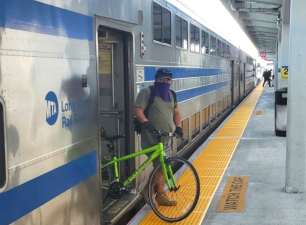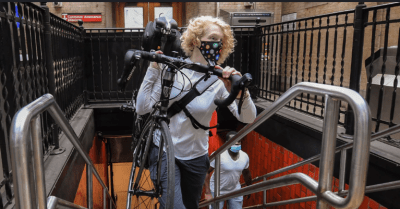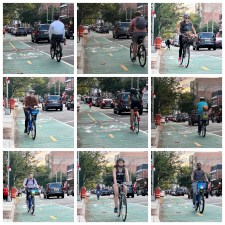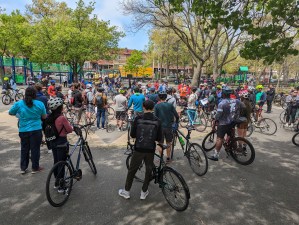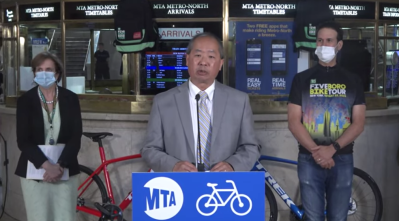State Bike Survey Shows Demand for Secure Parking at Transit Hubs
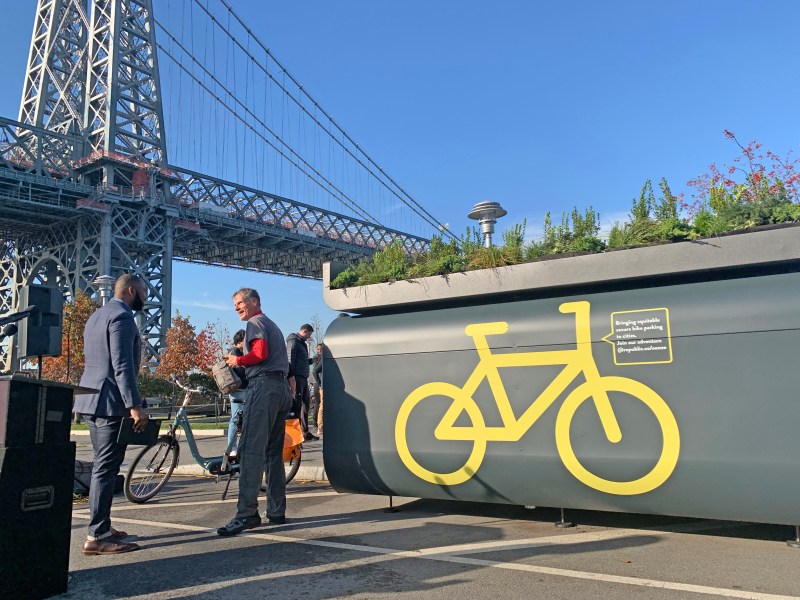
Cyclists want to park and ride, too!
Respondents to the ongoing New York Bike Census are making it known that they want a secure place to park their two-wheeled rides at train and bus stops around the state.
According to Dan Suraci, the CEO of Urban Cycling Solutions which is helping to administer the statewide survey, more than half of the 12,000-plus survey takers said they would be willing to pay for secure bike parking outside of transit stations. Beyond the fact that cyclists would want to keep their rides out of the elements and away from the prying tools of bike thieves, the results show a latent demand for cycling trips to transit stations, if only there was a safe place to lock up, Suraci said.
“In the city, walking to transit is generally a no-brainer, but in some of the less transit rich areas of Queens, Brooklyn or the Bronx, biking two to three miles to the nearest bus or subway stop makes a lot of sense,” he said. “Even residents in South Yonkers or Mount Vernon might choose New York City Transit over Metro-North because it is less expensive, and a bike makes that journey a lot more feasible.”
Suraci also suggested that suburban communities with a little more density around them could benefit the people who said they were looking for combinations of bike parking and transit.
“From a commuter rail standpoint, there are a lot of transit-oriented development-type communities out there which are perfect for a one- to three-mile bike ride. Unfortunately, many stations either don’t have bike parking at all or have a couple of U-racks without any sort of weather protection or sense of real security. Meanwhile, at stations like Beacon on Metro-North, we have overwhelming demand for car parking, so much so that there is an extensive waitlist for an already huge and overcrowded parking lot,” said Suraci.
The MTA is making small moves in terms of secure bike parking and micromobility, including installing an Oonee bike pod outside Grand Central Terminal and also conducting a study on first mile/last mile access to suburban commuter rail stations. Its recent presentations related to the study haven’t included secure bike parking as a solution in the suburbs, but the agency is seeking outside companies to put together its legislatively mandated bike and pedestrian access plan, which could wind up emphasizing better bike parking at MTA-owned real estate. A spokesperson for the MTA also said that the transit agency is looking to expand secure bike parking access at other commuter rail stations.
For one leading voice on secure bike parking in New York City, the data simply confirmed something that has been gone over ad nauseam for years.

“It’s not surprising,” said Oonee founder and CEO Shabazz Stuart. “I don’t know how much more data we need to reach the long overdue conclusion that secure and protected bike parking is essential to a viable cycling-as-transit ecosystem.”
Stuart’s Oonee has been running a roving pilot of one of its bike curbside parking installations in various neighborhoods in New York City since it debuted in the Meatpacking District in mid-March, which is the the closest the city has come to a commitment to providing curbside secure bike parking. Before the Oonee mini began its tour, previous attempts to provide secure bike parking ended in failure, even though a pilot program for bike parking was supposed to be an early goal of then-Mayor de Blasio’s Green Wave program. Additionally, cycling activists brought up the need for much more robust secure bike parking offerings as far back as 2016.
But instead of his hometown Big Apple, Stuart has found the Garden State more eager to enact to his bike parking vision. Oonee is going to eventually have thirty bike parking pods in Jersey City, with seven coming online in 2022, and is also working on an expansion of its presence on Port Authority property. Well before the installation of an Oonee pod at Grand Central, Oonee installed a larger unit at the Port Authority’s Journal Square transit hub in Jersey City. Stuart said that commuters in the area took very quickly to having a safe place to stash their bikes, confirming the data from the bike census.
“There are a lot of people who’ve said they would not be using their bike to get to Journal Square because they didn’t feel like buying a new bike, just to have it stolen or come back to Journal Square from Manhattan just to have a wheel missing. And now with secure bike parking they can use with confidence, cycling becomes an opportunity for them,” he said.
Bike theft wasn’t just a problem around Journal Square of course, as the crime spiked nationwide during the pandemic at the same time that bike ridership and demand jumped. Bike thefts rose from 3,507 reported thefts a year before the pandemic began to 4,447 in New York City, demonstrating the need for secure bike parking everywhere, not just at transit hubs. Delivery riders have also been targets of thieves trying to steal their e-bikes, something that Oonee has been able to temper at least when the bikes are parked during a delivery.
“Grand Central is predominantly a commuter facility, but it’s also a facility that we see used by working cyclists making deliveries to Grand Central, because you can’t take your bike inside Grand Central, nor would you want to use that,” said Stuart.
The bike census itself, which is a joint project of UCS and the New York State Energy Research and Development Authority, began in February with the goal of collecting “detailed data on bicycle transportation across the state.” Because of the huge response rate to it so far, which Suraci said was “a raw indicator of the interest in better cycling all over the state,” the survey will remain open until the end of May. Given the early data coming out from it, Stuart said he was hopeful it would be a kick in the pants for New York officials to embrace more pods.
“It’s time we adopt a more mature, visionary, bolder strategy for the future of bike parking. And I hope that this census gives the administration in cities across the state, including our own, the policy rationale, to get moving,” he said.
To fill out the survey, click here.
